Genre: Beat-‘Em-Up Developer: Kid Corp. Publisher: Dreamworks Players: 1 Released: 1991
Like many people of the time, I didn’t get a Sega Genesis until sometime in 1991, when Sonic the Hedgehog was being packaged with the system. Naturally, after loving Sonic I had to rent Genesis games so that I could see which titles were good and which ones weren’t. One of those games was a beat-‘em-up called Mystical Fighter. Of course, all the Japanese themes were lost on me, but the gameplay was what grabbed me. For whatever reason, though, I never bought the game until years later to see if it was still as good as my memories had me thinking it was. The answer, thankfully, is that while it may not be up there with likes of Streets of Rage or Golden Axe, Mystical Fighter can still hold its own.
Originally published by Taito in Japan under the name Maou Renjishi, the game was published in North America by DreamWorks, the same company who brought us games like Target Earth and the cult-classic Fire Shark. The story is very basic, as is common in the genre, and all that’s important is that you, as well as a friend, play as Kabuki warriors against the evil forces of the Evil Lord Kabuki, or Darkside Kabukimaster as he’s called in-game. Yeah, this game is definitely Japanese in style and DreamWorks didn’t bother to try and hide it. If anything, though, it gives Mystical Fighter an original look and style to it, making it easier to identify among the multitude of beat-‘em-ups the Genesis has.
To combat the forces of evil, you have a basic attack as well as a jump kick and a sliding kick which is done while rolling, which is this game’s equivalent of running. There are two weapons: a fan that goes back and forth across the screen and a jutte that’s pretty useful, but they rarely show up and end up being more like gimmicks. You can also find and collect magic scrolls which allow you to use special magic attacks that affect the entire screen. Magic is done Golden Axe 1-style, where the magic attack you use depends on how many magic scrolls you’ve collected at the time, with five being the max.
The real fun, though, is when you grab an enemy. By simply walking into someone you grab them, and from that moment you have three choices. The first is that you simply pick up the enemy and throw them away, preferably into other on-screen enemies. The second is to pick up the enemy, jump, and at the top of the jump press the attack button. You promptly flip upside-down and crash the enemy into the ground. As entertaining and fun as that attack is, though, the best is when you press the attack button right after grabbing the enemy. This results in you swinging him around by the feet, and with the ability to move around while doing this you become a human wrecking machine. While this does damage the enemy slowly and hurts all that comes into contact with the move, it also takes away from your health, making it more of a crowd-control move that shouldn’t be abused. Throughout it all, the controls are solid and respond nicely, though moving around in short bursts results in an odd stutter animation that might be annoying here and there.
Graphically, though, the game is a little underwhelming. When Mystical Fighter came out in North America in 1992 there were already a good number of titles that showed what could be done graphically on the Genesis, and it was even true to lesser extent when it originally came out in Japan in 1991. Still, the game does look nice, with a nice use of color to give it a fitting historical Japan look, and the characters do animate well enough. There is a small variety in enemies, but the coloration of many of them are just bizarre, resulting in things such as orange samurai and purple sumo wrestlers.
The biggest treat, though, is with the music. Every stage theme is memorable to some extent and catchy. You’ll be humming along with the music just about every time you play the game, which is always a plus. Sound effects are mostly standard fare and work well enough.
That’s not to say that the game has no flaws, though. At only five stages, plus a short sixth stage when played on the hard difficulty, Mystical Fighter is a little on the short side, especially when only two of the stages have multiple sections to them. Also, outside of the grab mechanics, there isn’t too much depth to the game either, which might turn off some players. There are only two difficulties settings, normal and hard, but they’re not exactly balanced well. On normal, it’s a very easy game, but hard suddenly makes the enemies way more aggressive. Also, hard has a bad habit of just grouping multiple enemies in the same spot, so when they come out it looks like there’s only one enemy there, but in reality, there are actually two or even three. Finally, the bosses can be pretty pathetic, even on the hard setting. Once you find out their pattern or at least know how and when to attack them, you can defeat them without losing much or even any health whatsoever, which is disappointing.
But even with those flaws Mystical Fighter is just so much fun to play, and its style and look definitely keep it from being lost in the beat-‘em-up shuffle among the likes of the Streets of Rage series, Two Crude Dudes, and the Golden Axe series. It somewhat sad that Mystical Fighter is so unheard of, because within its admittedly simple gameplay lies a title that is just sheer fun to play, and its utterly Japanese style gives it an identity that other games in the genre can’t match. Not quite an “unsung classic,” but still enjoyable, nonetheless.
SCORE: 7 out of 10

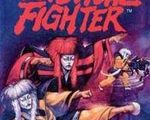
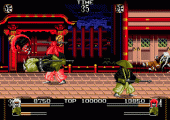
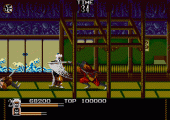
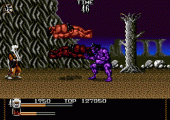
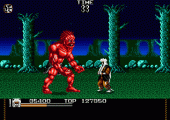
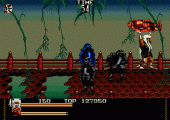
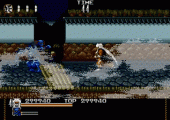
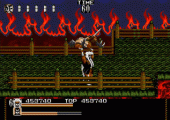
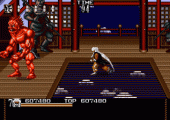
Recent Comments